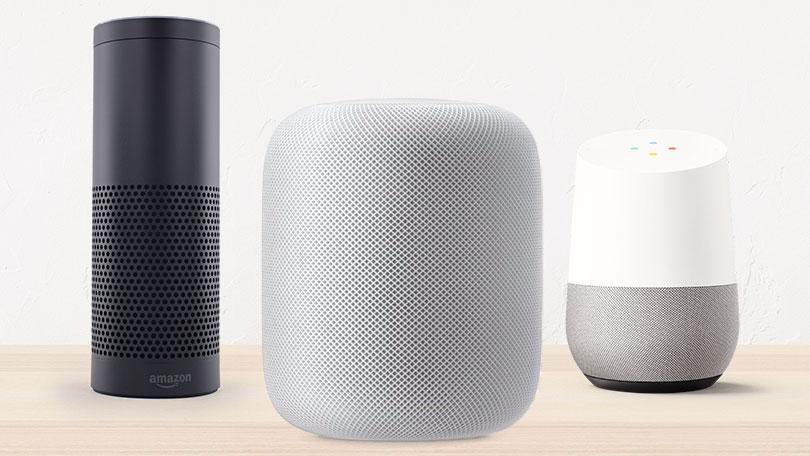The war to dominate voice technology is heating up – and getting more interesting. Both Amazon and Google have recently announced important enhancements to make their voice assistants, Amazon Alexa and Google Assistant, smarter and more useful. And to increase the level of competition, on June 5 Apple announced its HomePod smart speaker, powered by Siri, at the Apple Worldwide Developers Conference (WWDC). The ability of a consumer to search from multiple devices anywhere they are makes it clear that brands’ strategies need to adapt for voice searches.
Apple Plays Catch-Up
The launch of HomePod represents Apple’s attempt to gain a stake in the market for smart speakers activated by voice. Apple has been late to the playing field before, but when it enters, Apple creates hardware that leaves competitors in the dust. Think of the iPhone and how it changed people’s lives, and, even more so, the way people search.
Having access to another voice-activated device no matter where you are, whether it’s the HomePod, Apple Watch or iPhone, will only increase the use of voice search. Apple’s sneak peak of the HomePod mainly focused on its abilities for music in the home, but it also touched on similar smart speaker features such as weather, directions, messages, and reminders.
Additional Siri-related announcements included a new voice that is more conversational, which will match with the way consumers speak to Siri. Apple also announced a new Siri-powered watch face for the Apple Watch. Apple is enhancing Siri on the Apple Watch by using machine learning to gather data on how you utilize your device. Siri will use this data to then show you relative and interesting content.
Apple’s release of HomePod occurred on the heels of Google’s and Amazon’s own announcements related to voice technology. It’s instructive to review how Amazon and Google built off their already established products to differentiate themselves.
Amazon Integrates Voice and Search with Echo
On May 9, Amazon – which dominates 70 percent of the market for voice controlled speakers – announced that its Echo voice-activated home speaker is getting more visual. The new Echo Show product includes a touch screen that integrates visual features with voice. According to Amazon, “Echo Show brings you everything you love about Alexa, and now she can show you things. Watch video flash briefings and YouTube, see music lyrics, security cameras, photos, weather forecasts, to-do and shopping lists, and more. All hands-free—just ask.”
In addition, Echo Show users can make video calls, thus making Echo Show a competitor to Apple’s FaceTime, Google’s Hangouts, and Microsoft’s Skype.
What Echo Show does for brands and consumers is create a more integrated way for them to share content with each other. For instance, consumers can ask Alexa to make their dining reservations at a restaurant and also call up a menu, display available movie times at different theaters, and watch movie trailers, among many other possibilities.
According to Mashable’s Lance Ulanoff, “The Amazon Echo Show is a quantum leap beyond any Alexa-infused product we’ve seen before” because of the new interface with the touch screen. He also noted that Echo Show will always communicate with you, while other devices wait for you to initiate.
It’s obvious Amazon is becoming a stronger platform for amplifying your brand through paid and organic content, both visual and voice-related. If you do not have an Amazon strategy yet, True Interactive highly recommends experimenting with advertising on their platform.
Google Gets Smarter
Meanwhile, at its annual I/O event, Google introduced a slew of features to make Google Home and Google Assistant more useful.
As if to answer Amazon Echo, Google launched Visual Responses, which also integrates visual content with voice. As Google noted on its blog, “You’ll be able to see Assistant answers on the biggest screen in your house, whether you’re asking ‘what’s on YouTube TV right now?’ or ‘what’s on my calendar today?’”
In other words, Google provides the same functionality as Amazon but with the power of the Google search and discovery ecosystem more closely integrated into the experience.
Google made many other enhancements to Google Assistant and Google Home. For instance, with Proactive Assistance, Google Home sends people information without being asked. So if you have an appointment with your doctor entered on your Google calendar, Google Home will remind you of the date and time, suggest a driving route, or provide other useful information such as helpful stops on the way to the doctor.
Another interesting improvement consists of making Google Assistant more conversational and more contextual. As Google noted on its blog, we often want to have follow-up conversations with Google Assistant. So Google has made it possible to see the history of your conversation with Google Assistant as you would a text thread, thus making it easier for you to re-engage with a conversation – say, managing a shopping list at the store after you’ve started one and then had your trip to Target interrupted by something else.
Bottom Line
Google, Amazon and Apple understand that people and brands find each other in more sophisticated, multi-dimensional ways. All of these companies have evolved to incorporate voice search tools and now multi-media discovery platforms.
Brands need to think of themselves as multi-media advertisers in the world that Amazon, Google and Apple are shaping. Performance media is not an either/or choice between voice, text-based, and visual platforms such as Instagram and YouTube. These three leading brands are forcing businesses to think of their media as overlapping, integrated platforms.
Virtual assistants are using machine learning to understand the consumer’s voice, interests, behaviors and intent to give them a better search experience. And with voice-activated devices advancing, consumer’s search behavior is shifting. We’ve mentioned before that voice searches are more conversational and natural. Advertisers now need to focus their content strategy not only around conversational language, but also visuals and the context of the search including the type of device and location.
Image source: PC Magazine
